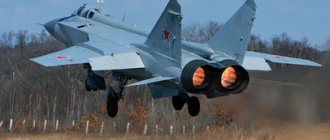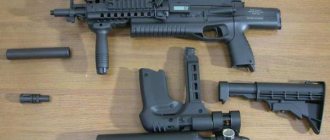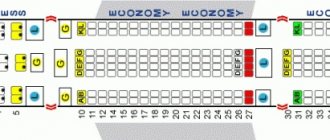Although the era of the Cold War is in the past, today there are still enough problems in the world that must be solved with the help of the latest developments in the field of weapons. At first glance, the world's main problems come from terrorist groups; relations between some major world powers are also quite tense.
Recently, relations between Russia and the United States have become extremely strained. Using NATO, the United States surrounds Russia with missile defense systems. Concerned by this, Russia has begun developing hypersonic aircraft, so-called “drones,” that can carry nuclear warheads. It is with these projects that the secret supersonic glider Yu-71 is associated, the tests of which are carried out in the strictest secrecy.
History of the development of hypersonic weapons
The first tests of aircraft capable of flying at speeds exceeding the speed of sound began back in the 50s of the 20th century. This was associated with the era of the Cold War, when the two strongest superpowers in the world (the USA and the USSR) tried to beat each other in the arms race. The first Soviet development in this area was the Spiral system. It was a small orbital aircraft, and had to meet the following parameters:
- The system was supposed to be superior to the American X-20 "Dyna Soar", which was a similar project;
- The hypersonic carrier aircraft was supposed to provide a speed of about 7,000 km/h;
- The system had to be reliable and not fall apart under overload.
Despite all the efforts of Soviet designers, the characteristics of the hypersonic carrier aircraft did not even come close to the coveted speed figure. The project had to be closed because the system did not even take off. To the great joy of the Soviet government, the American tests also failed miserably. At that time, world aviation was still infinitely far from speeds exceeding several times the speed of sound.
Tests that were already closer to technologies related to hypersound took place in 1991, then in the USSR. Then the flight of “Kholod” was carried out, which was a flying laboratory created on the basis of the S-200 missile system, based on the 5B28 rocket. The first test was quite successful, as it was possible to reach a speed of about 1,900 km/h. Developments in this area continued until 1998, after which they were curtailed due to the economic crisis.
What is hypersound, and how does it happen?
Hypersonic is a speed that is significantly - five or more times - greater than the speed of sound in the atmosphere. Accordingly, hypersonic aircraft (HSAV) are capable of moving at such speeds and performing maneuvers using aerodynamic forces.
Five speeds of sound or five Mach numbers (5 Mach) are approximately from 5380 km/h to 6120 km/h depending on flight altitude. The division of aircraft into sub-, super-, and hypersonic clearly reflects the nature of the phenomena that arise when the aircraft interacts with the oncoming air flow. This gradation is especially important for the operation of the power plant of an aircraft or rocket: an ordinary turbojet engine simply cannot operate at hypersound; a ramjet or rocket engine is needed. The usual flight altitude for HZVs is the range from 25 to 100 km; below, near the surface of the Earth, hypersonic vehicles are not used due to too much air resistance.
American hypersonic missile Boeing X-51 WaveRider
Today, designers are faced with another task: to create aircraft for which flight at hypersonic speed would be a standard mode, capable of maneuvering, braking and landing. These are various spaceplanes (American Space Shuttles and Soviet Buran), hypersonic aircraft (X-15, SpaceShipOne), UAVs (Boeing X-43). GZLA also includes combat-guided ICBM units ("Avangard") and hypersonic missiles (X-51 Waverider and "Dagger").
Development of supersonic technologies in the 21st century
Although there is no exact information on the development of hypersonic weapons for the period from 2000 to 2010, having collected materials from open sources, one can see that these developments were carried out in several directions:
- First of all, warheads are being developed for ballistic intercontinental missiles. Although their mass is much higher than conventional missiles of this class, due to maneuvers in the atmosphere they will not be intercepted by standard missile defense systems;
- The next direction in the development of supersonic technologies is the development of the Zircon complex. This complex is based on the supersonic missile defense system "Yakhont/Oniks";
- A missile system is also being developed, the rockets of which will be able to reach speeds that exceed the speed of sound 13 times.
If all these projects are united in one holding company, then the rocket that will be created through joint efforts can be both ground-based, airborne or ship-based. If the American project “Prompt Global Strike,” which envisages the creation of supersonic weapons capable of hitting anywhere in the world within one hour, is successful, Russia will only be able to be protected by intercontinental supersonic missiles of its own design.
Russian supersonic missiles, the tests of which are recorded by British and American experts, are capable of speeds of about 11,200 km/h. They are almost impossible to shoot down and even extremely difficult to track. There is very little information about this project, which is often referred to as Yu-71 or “object 4202”.
Advantages and disadvantages of space exploration
There are several advantages of certain types of developments, but mainly due to the low level of knowledge of this industry, the disadvantages mainly predominate. The advantage of a hypersonic vehicle like the X-30 is the reduction or elimination of the transported oxidizer. Since approximately 75% of the entire aircraft structure is oxidizer. The elimination of this mass will lead to a lighter weight of the device, and therefore an increase in payload. In turn, this will reduce the cost of transporting various cargo into orbit.
A liquid rocket engine or liquid propellant rocket engine has significant differences in high thrust in relation to mass, which, in turn, allows rockets to achieve enormous performance in delivering cargo into orbit. Under the conditions of using a scramjet engine, the ratio increases, which will lead to an increase in the share of the engine in the mass of the device.
The main disadvantage is the high cost of not only the development of space programs and research of hypersonic vehicles, but also of further operation. Replenishing fuel, replacing spare parts and components - all this together greatly increases the price of such programs.
The most famous facts about Russia's secret weapon Yu-71
The secret Yu-71 glider, which is part of Russia's supersonic missile program, is capable of flying to New York in 40 minutes. Although this information has not been officially confirmed, based on the fact that supersonic Russian missiles are capable of reaching speeds of over 11,00 km/h, exactly the same conclusions can be drawn.
According to the little information that can be found about it, the Yu-71 glider is capable of:
- Fly at speeds over 11,000 km/h;
- Has incredible maneuverability;
- Able to plan;
- During the flight it can go into space.
Although the tests have not yet been completed, everything suggests that by 2025, Russia may have this supersonic glider armed with nuclear warheads. Such a weapon will be capable of reaching almost anywhere in the world within an hour and delivering a targeted nuclear strike.
Dmitry Rogozin said that the Russian defense industry, which was the most developed and advanced during the Soviet era, fell far behind in the arms race during the 90s and 2000s. Over the past decade, the Russian army has begun to revive. Soviet technology is being replaced by modern high-tech models, and fifth-generation weapons, which have been “stuck” in design bureaus in the form of projects on paper since the 90s, are beginning to take on very specific shapes. According to Rogozin, new Russian weapons may surprise the world with their unpredictability. By unpredictable weapon, they most likely meant the Yu-71 glider, armed with nuclear warheads.
Although this device has been in development since at least 2010, information about its tests reached the US military only in 2015. The Pentagon fell into complete despondency because of this, because if the Yu-71 is used, the entire missile defense system, which is installed along the perimeter of Russian territory, becomes absolutely useless. In addition, the United States of America itself becomes defenseless against this secret nuclear glider.
The Yu-71 is capable of not only delivering nuclear strikes against the enemy. Thanks to the presence of a powerful, ultra-modern electronic warfare system, the glider is capable of disabling all detection stations equipped with electronic equipment in a few minutes while flying over US territory.
If you believe NATO reports, then from 2020 to 2025, up to 24 Yu-71 type devices may appear in the Russian army, any of which is capable of crossing the enemy border undetected and destroying an entire city with a few shots.
The main difficulties facing designers
More than half a century has passed since the first flight of the X-15 rocket plane, and there have been no serial hypersonic vehicles. The reason for this is a number of complex technical problems that the designers had to face.
The first and probably the main one is the extreme heating of the body that occurs at hypersonic speeds. Titanium, the most advanced alloys, ceramics, and nanomaterials are used to make the airframe and engines. But so far this does not help much: it is precisely because of the high heating that the operating time of most GZLAs is calculated in minutes.
American rocket plane X-15
Another major problem of hypersonic flight is the engine. A conventional turbojet engine is not capable of operating at such speeds; other solutions are needed. Of course, you can use a rocket engine - like on the X-15 - but it is too complicated, expensive and wasteful. A ramjet hypersonic engine is most suitable for a GZLA; the only problem is that it simply will not start at speeds below Mach 5. Therefore, some GZLAs are equipped with additional upper stages.
The fastest production aircraft
The hypersonic vehicles we studied above actually belong to the research category. It will be useful to consider some production models of aircraft that are close in characteristics to hypersonic ones or are (according to one methodology or another) hypersonic ones.
Among such machines is the American development of the SR-71. Some researchers are not inclined to classify this aircraft as hypersonic, since its maximum speed is about 3.7 thousand km/h. Among its most notable characteristics is its take-off weight, which exceeds 77 tons. The length of the device is more than 23 m, the wingspan is more than 13 m.
The Russian MiG-25 is considered one of the fastest military aircraft. The device can reach speeds of more than 3.3 thousand km/h. The maximum take-off weight of a Russian aircraft is 41 tons.
Thus, in the market for serial solutions with characteristics close to hypersonic ones, the Russian Federation is among the leaders. But what can be said about Russian developments regarding “classic” hypersonic aircraft? Are engineers from the Russian Federation capable of creating a solution that is competitive with machines from Boeing and Orbital Scence?
"Zircon" for the fleet
On March 17, 2020, it became known that Russia had officially begun testing the Zircon hypersonic anti-ship cruise missile (ASC). The fifth-generation nuclear submarines (Husky) will also be armed with the newest projectile; surface ships and, of course, the flagship of the Russian fleet, Peter the Great, will also receive it. A speed of 5-6 M and a range of at least 400 km (the missile will cover this distance in four minutes) will significantly complicate the use of countermeasures. It is known that the rocket will use the new Decilin-M fuel, which increases the flight range by 300 km.
The developer of the Zircon anti-ship missile system is NPO Mashinostroeniya, part of the Tactical Missile Weapons Corporation. The appearance of a serial rocket can be expected by 2020. It is worth considering that Russia has extensive experience in creating high-speed anti-ship cruise missiles, such as the serial P-700 Granit anti-ship missile (2.5 M), the serial P-270 Moskit anti-ship missile (2.8 M), which will be replaced by the new Zircon anti-ship missile system.
Aircraft from North American
Another famous hypersonic aircraft is the X-15, produced by North American. Analysts classify this apparatus as experimental.
It is equipped, which gives some experts a reason not to classify it, in fact, as an aircraft. However, the presence of rocket engines allows the device, in particular, to perform So, during one of the tests in this mode, it was tested by pilots. The purpose of the X-15 device is to study the specifics of hypersonic flights, evaluate certain design solutions, new materials, and control features of such machines in various layers of the atmosphere. It is noteworthy that it was approved back in 1954. The X-15 flies at a speed of more than 7 thousand km/hour. Its flight range is more than 500 km, its altitude exceeds 100 km.
Projects from other countries
It is known that China and the United States are also developing an analogue of the Russian hypersonic aircraft. The characteristics of the enemy models are still unclear, but we can already assume that the Chinese development is capable of competing with the Russian aircraft.
Known as the Wu-14, the Chinese aircraft was tested in 2012, and even then it was able to reach speeds of over 11,000 km/h. However, there is no mention anywhere about the weapons that this device is capable of carrying.
As for the American Falcon HTV-2 drone, it was tested several years ago, but 10 minutes into the flight it crashed. However, before it, the X-43A hypersonic aircraft was tested, which was carried out by NASA engineers. During tests, it showed a fantastic speed of 11,200 km/h, which is 9.6 times the speed of sound. The prototype was tested in 2001, but then during the tests it was destroyed due to the fact that it got out of control. But in 2004 the device was successfully tested.
Similar tests by Russia, China and the United States cast doubt on the effectiveness of modern missile defense systems. The introduction of hypersonic technologies in the military-industrial sector is already producing a real revolution in the military world.
In works of art and popular culture
In movie
- The 1960s Soviet film Barrier of the Unknown depicts the testing of a fictional experimental hypersonic aircraft powered by a nuclear rocket engine.
- The television movie Starflight: The Plane That Never Lands (1983) proposes the concept of a hypersonic passenger-carrying jet airliner developed by a fictional aircraft. The aircraft uses a scramjet engine to reach a high point in the stratosphere for a two-hour journey from Los Angeles to Sydney using hydrogen as fuel. Since NASA has experience with this fuel, it is used to refuel an airliner that gets stuck in orbit due to an accident.
- In the 2005 film Stealth Plane, fictional military aircraft and EDI UAVs use scramjet-powered pulse detonation engines.
In other media
- The Mave fighter in the Japanese animated film Yukikaze
had a mode in its list of capabilities called RAM-AIR, which was stated to be , but was more of a scramjet engine in capabilities. - In the episode "Pandora's Box" of the CBS television show Numbers, the plane that crashed was carrying a scramjet engine as undeclared cargo.
- One of the engine type options in Ace Combat X: Skies of Deception
for an aircraft with a customizable set of engines and other components is called SCRAMjet.
Impact from orbit
We will talk about hypersonic maneuvering controlled objects - maneuvering warheads of ICBMs, hypersonic cruise missiles, hypersonic UAVs. What exactly do we mean by hypersonic aircraft? First of all, we mean the following characteristics: flight speed - 5-10 M (6150-12,300 km/h) and above, covered operating altitude range - 25-140 km. One of the most attractive qualities of hypersonic vehicles is the impossibility of reliable tracking by air defense systems, since the object flies in a plasma cloud, opaque to radar.
It is also worth noting the high maneuverability and minimal reaction time to defeat. For example, a hypersonic vehicle requires only an hour after leaving the waiting orbit to hit the selected target.
Projects for hypersonic vehicles have been developed more than once and continue to be developed in our country. You can recall the Tu-130 (6 M), the Ajax aircraft (8-10 M), the projects of high-speed hypersonic aircraft from the Design Bureau named after. Mikoyan on hydrocarbon fuel in various applications and a hypersonic aircraft (6 M) on two types of fuel - hydrogen for high flight speeds and kerosene for lower ones.
The Boeing X-51A Waverider hypersonic missile being developed in the United States.
The OKB project left its mark in the history of engineering. Mikoyan “Spiral”, in which the return aerospace hypersonic aircraft was launched into artificial satellite orbit by a hypersonic booster aircraft, and after completing combat missions in orbit, returned to the atmosphere, performing maneuvers in it also at hypersonic speeds. Developments from the Spiral project were used in the BOR and Buran space shuttle projects. There is officially unconfirmed information about the Aurora hypersonic aircraft created in the United States. Everyone has heard about him, but no one has ever seen him.










